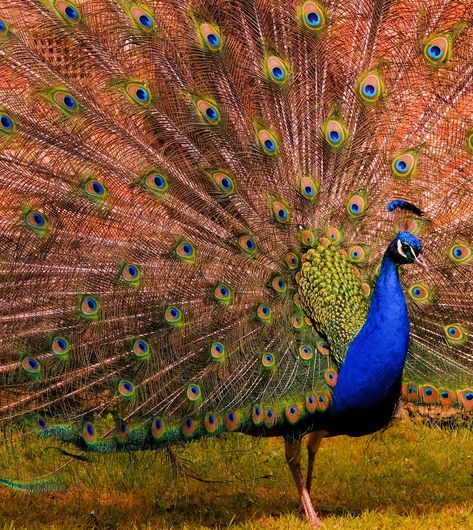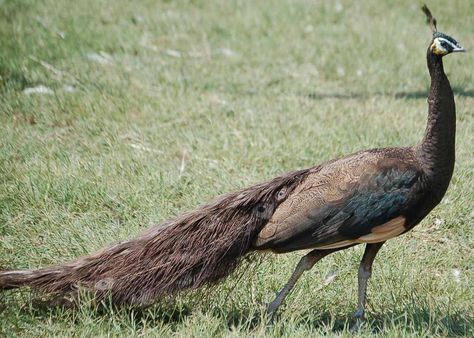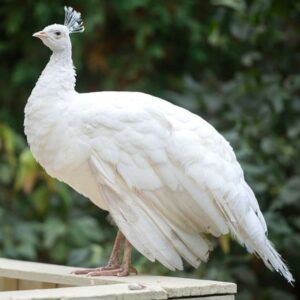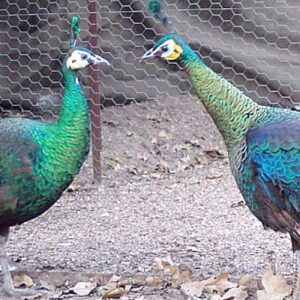The Bronze Peafowl is a remarkable and visually captivating color variation of the Indian Peafowl (Pavo cristatus), characterized by its stunning bronze, golden, and copper-hued plumage. This rare mutation creates a bird that shines with a warm, metallic sheen, offering a dazzling display of iridescent colors that are a true feast for the eyes. The Bronze Peafowl shares many characteristics with the traditional Indian Peafowl, but its striking coloration makes it a sought-after bird for ornamental purposes, as well as a symbol of grace and elegance in gardens, aviaries, and private collections.
Physical Characteristics
The most distinctive feature of the Bronze Peafowl is its iridescent plumage, which is predominantly made up of rich bronze, gold, and copper tones. This eye-catching color variation gives the bird an ethereal, glowing appearance in sunlight, as the feathers catch the light in a mesmerizing way.
Males (Peacocks):
- Plumage: Males boast a long, iridescent train, which is the highlight of their appearance. The train features eye-like patterns that shimmer in shades of bronze, gold, and green. The overall effect is a warm, metallic glow that stands out compared to the more traditional blue and green feathers of the Indian Peafowl.
- Body: The body of the male Bronze Peafowl is typically a rich brownish bronze with gold-toned accents, especially around the neck and chest. The head and crest of the male are covered with bronze-colored feathers, completing the bird’s regal appearance.
- Size: Male Bronze Peafowls are larger than females, typically reaching up to 3 feet (90 cm) in body length, with their stunning tail feathers extending an additional 4–6 feet (120–180 cm), making them one of the most visually striking birds in the world.
Females (Peahens):
- Plumage: Female Bronze Peafowls have a more subdued coloration compared to the males but still retain some of the bronze and golden hues. The peahen’s plumage is typically a blend of browns, taupes, and soft golds, giving her a more understated yet still elegant appearance.
- Size: Female Bronze Peafowls are smaller than their male counterparts, typically about 2–2.5 feet (60–75 cm) in length. They have a shorter tail, making them less flamboyant than the males, but still beautiful in their own right.
Behavior and Social Structure
Bronze Peafowls exhibit the same social behavior and habits as the traditional Indian Peafowl:
- Social Structure: These birds are highly social and prefer living in groups, especially during the non-breeding season. Males typically form a loose hierarchy based on size and the quality of their displays, while females tend to remain more dispersed, often with their chicks.
- Vocalization: Like all peafowls, the Bronze Peafowl is known for its loud, distinctive calls, especially during the mating season. Males will often call out to announce their presence to females or to warn other males of their territory.
- Foraging: Bronze Peafowls are omnivores, feeding on a wide variety of foods, including seeds, fruits, grains, insects, and small reptiles. They are excellent foragers and are often seen foraging in open areas or under trees, looking for food.
Courtship and Reproduction
The courtship display of the Bronze Peafowl is one of its most remarkable features. During mating season, males use their spectacular train to attract females. The peacock will spread its train into an impressive fan shape, shaking the feathers to create a shimmering, dazzling effect. He will also perform a series of calls, strut, and may even perform a “dance” to catch the attention of a female.
- Breeding: During the breeding season, males compete for the attention of females, using their train as a primary form of display. The female chooses a mate based on the size and vibrancy of his train, as well as his overall health and appearance.
- Egg Laying: After mating, the female lays 3–6 eggs in a hidden ground nest, typically located in tall grass or dense shrubs. The incubation period lasts approximately 28–30 days, with the female incubating the eggs and providing care for the newly hatched chicks.
- Chicks: The chicks are precocial, meaning they can walk and forage shortly after hatching. However, they remain close to the mother for protection and guidance during the early stages of their life.
Habitat and Distribution
The Bronze Peafowl is primarily found in captivity, as it is a result of selective breeding. The natural habitat of the Indian Peafowl from which it originates includes the forests, grasslands, and open woodlands of the Indian subcontinent and parts of Southeast Asia. However, due to its unique coloration, the Bronze Peafowl is often kept in private estates, ornamental gardens, and zoological parks.
- Habitat Preferences: Like other peafowls, Bronze Peafowls prefer environments that offer both open spaces for foraging and areas with dense vegetation for shelter and nesting.
- Adaptability: Bronze Peafowls are hardy birds that can adapt to a wide range of climates and environments, though they are typically found in warmer regions, where they can thrive and display their colorful plumage.
Conservation and Breeding
As a selectively bred variety of the Indian Peafowl, the Bronze Peafowl is not considered a threatened species. However, its limited population in the wild makes it a rare and sought-after bird for ornamental purposes.
- Selective Breeding: Breeding of the Bronze Peafowl involves careful management to maintain the purity of its coloration while ensuring that genetic diversity is preserved.
- Conservation Efforts: Though not endangered, the genetic diversity of peafowls in captivity is important, and breeding programs often focus on sustaining a healthy population of both traditional and rare color variations, like the Bronze Peafowl.
Conclusion
The Bronze Peafowl is a truly majestic bird that combines the classic elegance of the Indian Peafowl with a breathtaking array of warm, metallic hues. Its iridescent bronze, gold, and copper plumage creates a striking and regal appearance, making it a prized addition to any collection. Known for its mesmerizing courtship displays, social behavior, and beautiful feathers, the Bronze Peafowl remains one of the most admired and sought-after ornamental birds worldwide. Whether in a private garden, aviary, or zoological park, this peafowl continues to awe those fortunate enough to witness its beauty.









Reviews
There are no reviews yet.